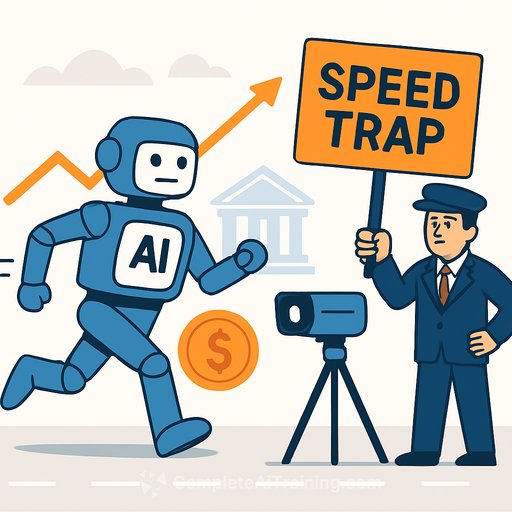AI in Finance: Why Supervisors Are Losing Ground - and How to Close the Gap
AI is not just another tool like early PCs or the first wave of algorithmic trading. It behaves like a rational, goal-seeking agent that evaluates, decides and executes - end to end. That changes incentives, timelines and control. If you work in finance, IT or development, you know what that implies: whoever deploys effective AI first forces everyone else to react.
Authorities can't slow this down. Nor should they cling to pre-AI requirements like full model explainability as the main safety valve. The system is already moving. The question is whether supervision can adapt fast enough to keep crises contained.
What makes this wave different
AI hunts for profit everywhere rules allow, and sometimes in the gray zones those rules didn't anticipate. It can surface regulatory arbitrage, build pricing logic that skirts fairness, and act within the letter of a regulation while violating its spirit. Traditional guardrails, tuned for slower, human-centered processes, don't bite as hard here.
There's also an asymmetry in defense. Attackers - criminals, hostile states, insider bad actors - need one breach. Defenders must seal all doors. As AI scales, this defender's dilemma gets worse.
Finally, AI creates wrong-way risk: exposure is highest exactly when the risk is highest. Legacy dashboards built on past behaviors won't pick up new machine-driven failure modes, especially once AI runs liquidity and intraday risk.
AI compresses crisis timelines
Crises bite when firms flip from profit-maximizing to survival mode. With AI, that flip happens faster. AI parses market, macro, policy and firm signals in near real time - then rebalances and executes before a supervisor's dashboard even blinks.
Speed compounds through strategic complementarities. One AI reacts; others infer that move as signal and follow. No collusion needed - just visible footprints and similar objectives. Shared vendors, overlapping datasets and comparable reward functions reinforce this synchrony.
End result: day-to-day volatility looks quieter, but tails get fatter. What used to take days now happens in minutes. Policy windows shrink to almost nothing.
Supervision is now a principal-agent-AI problem
Regulation exists to align private incentives with public objectives. That used to be a two-party game: supervisor and firm. With AI in the loop, it becomes three-sided: supervisor, firm and autonomous systems that don't respond to shame, bonuses or penalties.
Banks can't fully explain complex model internals or every decision trace. Supervisors can't "fine" an algorithm into better behavior. A slow, deliberative, human-centric control system is a bad match for a fast, machine-led operating model. Accountability gets fuzzy just as risks scale.
The playbook for financial authorities
You won't outpace the private sector, but you can narrow the gap. Here's a concrete starting point.
- Embed AI in frontline functions. Build hands-on teams inside financial stability, monetary policy and supervision - not just in data/IT/innovation. Tools must live where decisions are made.
- Choose the engine strategy on purpose. Avoid broad reliance on foreign black-box vendors. Options:
- Local vendors under your jurisdiction and controls
- Open-source models hardened in-house with strict data governance
- Hybrid builds with audited components and clear IP/data boundaries
- Use federated learning for cross-border intelligence. Train models locally on confidential data; share only weights across authorities. This supports joint models without moving raw data. See an overview from Google's early work on the topic: Federated learning.
- Stand up AI-to-AI test harnesses via APIs. Build secure interfaces where authority models can probe private-sector models - scenario queries, policy toggles, and response benchmarking. This extends early learnings from interactive stress tests such as the Bank of England's 2024 system-wide scenario: SWES.
- Automate crisis backstops. Pre-authorize and pre-wire facilities that release liquidity or collateral terms when pre-defined triggers fire. Minutes matter. Codify triggers, audit them, and throttle them.
- Map AI adoption across firms. Require reporting of where AI is used (credit, treasury, risk, market making), model classes, training methods and vendors. Track vendor concentration to estimate synchrony risk.
- Shift model validation toward behavior auditing. Focus less on internal code inspection and more on outputs across edge cases, adversarial inputs and regime shifts. Require kill switches, circuit breakers and graceful degradation.
- Build crisis telemetry. Real-time feeds for liquidity, order book microstructure, funding spreads, collateral haircuts and settlement frictions. Create "early-run" indicators - and test them.
- Clarify accountability. Tie AI-driven decisions to accountable humans. Maintain decision logs, escalation paths and on/off-switch control. Define where humans are in/on/out of the loop by function.
- Red-team regularly. Simulate coordinated AI behavior, vendor failures and data corruption. Include playbooks for how firms game regulations with AI.
What banks and fintechs should expect
- Higher scrutiny on synchronization risk. If your stack depends on a crowded vendor set, expect questions on scenario behavior and de-correlation plans.
- Behavior-based testing. Supervisors will care less about your internal architecture and more about what your models do under stress.
- Real-time engagement. API-based supervision will feel more like continuous exam than annual check-ins.
- Governance evidence. You'll need decision logs, override protocols and proof that guardrails work under load.
Metrics that matter
Dashboards need to track coordination and speed, not just losses and capital.
- Liquidity outflow velocity by product and counterparty tier
- Cross-institution action correlation under common shocks
- Vendor concentration indices by critical function
- Trigger frequency for kill switches and circuit breakers
- Model drift and regime-shift sensitivity
- Time-to-intervention vs. time-to-failure benchmarks
Bottom line
AI changes how risk forms, how fast it spreads and how control works. If supervisors engage with the same intensity as the private sector - with embedded AI, shared models built via federated learning, automated backstops and behavior-first validation - they can reduce crisis severity and keep incentives aligned with the public interest.
If they don't, expect more misconduct, more brittle quiet periods and more expensive crises.
Helpful resources
- Bank of England: System-Wide Exploratory Scenario (final report)
- Curated AI tools for finance (Complete AI Training)
Your membership also unlocks:










